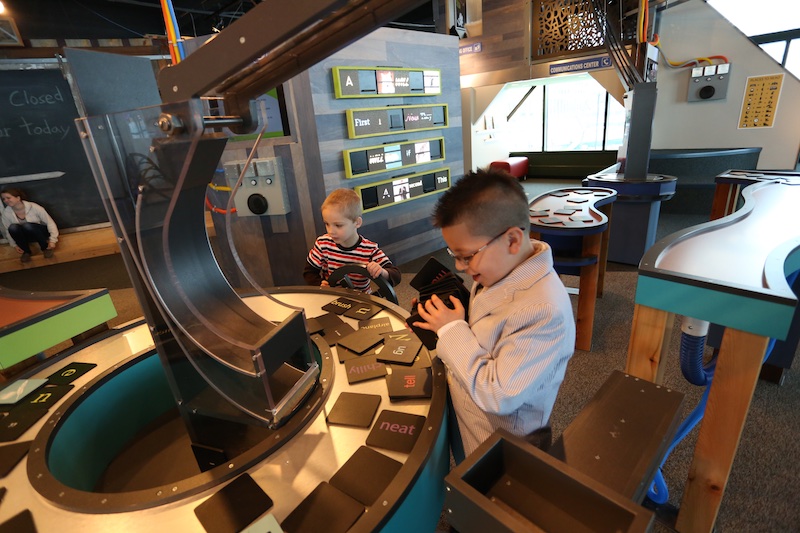Given the chance, my sons – when they were younger – would have gone to the Betty Brinn Museum, 929 E. Wisconsin Ave., every day. I was usually up for a visit once a week, any more than that and I wanted to poke my eyes out with Tinker Toys.
However, my kids’ fascination with the magical museum reflects what executive director Fern Shupeck sees every single day.
"Children never get bored with the museum," says Shupeck. "The parents, on the other hand, might get bored, but never the kids."
Kids’ love for the Betty Brinn Museum – which turned 20 years old this month – exists for a variety of reasons.
Wisconsin weather limits activities like going to the zoo or the park to a handful of months so indoor facilities are a change of scenery during winter’s long haul. However, it’s more than frigid temperatures that bring families to the museum in droves. The continuously changing and well-maintained exhibits attract more than 200,000 people to the museum every year.

"The museum’s attendance went from 150,000 to 200,000 in 2008 and at first we thought it was a reaction to the economy and that people were staying close to home instead of traveling," says Shupeck. "We anticipated that as the economy improved we would fall back to our prior attendance, but our attendance never went back."
Shupeck joined the Betty Brinn staff 18 years ago. Shupeck, who has an undergraduate degree in biological sciences and a law degree, decided she wanted to work with children. Originally from the East Coast, she had lived in the Midwest for some time, but decided to apply for the executive director position in Milwaukee because her sister lived here with her family.
"My sister sent me the classified ad for the job and said ‘come to Milwaukee, be Aunt Fern.’ When I applied for the job, I had never been inside a children’s museum," says Shupeck. "But the museum was struggling and looking for someone who was well-versed in running a non-profit and so I got the job."
When Shupeck started, the organization had ended 1997 with a 40 percent deficit. Shupeck identified a need for the museum to change the exhibit experience, retool the staff and undergo fierce strategic planning. By 2002, the museum was in the black and has never gone back.
"Clearly, they brought me on board to turn the boat in the other direction," says Shupeck.
The museum’s financial growth was due in part to the decision to stop renting exhibits from other institutions and to instead create exhibits that could be displayed locally as well as at other museums, science centers, schools and libraries around the world.
"We were renting big name exhibits like Curious George and Clifford that were beautiful to look at, but they were expensive and we decided they were not developmentally as strong as we wanted our exhibits to be," says Shupeck. "We now have an international reputation as exhibit developers and have had our exhibits in places as far away as the Middle East."
In 2006, the museum made $4,000 on exhibit rentals and the next year increased the earnings to $100,000. The most successful exhibits so far have been the Mr. Potato Head exhibit and the award-winning Smokey Bear / Woodsy Owl exhibit.
The increase in revenue allows the Betty Brinn Museum to offer low-income families free memberships through the Family Focus program. It also provides subsidized field trips to central city school groups and day cares.
Part of the museum’s success came out of crucial conversations circa 2000 about the focus of the museum.
"At first, we talked about expanding the age range of our target audience to include much older children, but ultimately we decided children should outgrow a children’s museum and move on to Discovery World and the public art museum and the art museum," says Shupeck. "We decided to stay true to our missions and find strategies to improve that rather than try to duplicate what other places were already doing."
Today, even though the museum is enjoyed by kids as old as 12, 93 percent of families who come to the museum have a child 5 or younger. This is due, in part, to more parents understanding the importance of brain development during the first five years of a child’s life.
"By the time a child goes on to kindergarten about 80 percent of the network of the brain has been established," says Shupeck. "We want children to go into school prepared and our mission is to help them develop fundamental school skills from literacy and reading to math to how to get along well with others and self esteem."
In 2016, the Betty Brinn Museum plans to open a new literacy-focused exhibit. This fall, the museum will reinstall the Tinker Toy exhibit and, just last week, the museum unveiled a new health and wellness area.
"It’s located right outside my office and the sound of children enjoying the activities in this exhibit interferes with my work in a really great way," says Shupeck.
Molly Snyder started writing and publishing her work at the age 10, when her community newspaper printed her poem, "The Unicorn.” Since then, she's expanded beyond the subject of mythical creatures and written in many different mediums but, nearest and dearest to her heart, thousands of articles for OnMilwaukee.
Molly is a regular contributor to FOX6 News and numerous radio stations as well as the co-host of "Dandelions: A Podcast For Women.” She's received five Milwaukee Press Club Awards, served as the Pfister Narrator and is the Wisconsin State Fair’s Celebrity Cream Puff Eating Champion of 2019.







